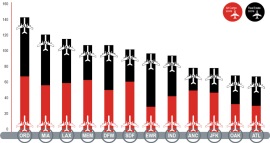by Brianna Crandall — May 11, 2015—With congestion issues and seaport gridlocks plaguing the transportation industry, air freight volumes are back on the rise. According to global commercial real estate services firm JLL’s annual Airport Outlook report, global air cargo saw a 4.5% annual increase in 2014, and the forecast calls for 5% growth in 2015. This has created a flurry of leasing, building and investment in the distribution center real estate surrounding key U.S. airports. And as a result, rents are rising for tenants, while returns rise for savvy investors.
 JLL’s Airport Index evaluates airports based on criteria such as availability of industrial and warehousing space, access to large population centers, and air cargo growth prospects.
JLL’s Airport Index evaluates airports based on criteria such as availability of industrial and warehousing space, access to large population centers, and air cargo growth prospects.(Click on image to enlarge)
Top airport locations for real estate investors
The report ranks the top airports for real estate investment in 2015, with Chicago’s O’Hare Airport (ORD) taking the top spot; followed by Miami (MIA) and Los Angeles (LAX). According to JLL, real estate investors with properties near these intermodal-friendly airports are reaping the benefits of higher rents, higher returns and lower vacancy rates, while of course tenants are feeling the squeeze while enjoying the benefits.
Intermodal connectivity, not population size, drives location popularity in 2015
It is not just the big cities that act as intermodal gateways, according to JLL’s Airport Index: Dallas (DFW) and Indianapolis (IND), Tier II and Tier III markets feature multi-modal options that can help alleviate potential supply chain interruptions and are increasingly popular with logistics executives. With numerous sites available to house big-box development, construction at these two airports over the past five years has grown. For example, 12 million square feet of warehouse space has been developed just outside DFW, and 13.7 million square feet surrounding Indianapolis airport.
JLL’s Index evaluates airports based on criteria such as availability of industrial and warehousing space, access to large population centers, and air cargo growth prospects.
Characteristics of the top airports
Supply and demand rule the day, says JLL. Leading airports face rising rents and low vacancy rates due to high demand from tenants whose cargo dictates close proximity to the hangars and runways. This translates to great interest from institutional investors, and high costs for the tenants seeking what little space remains on the market.
The top three airports all benefit from baseline location advantages, combined with ongoing infrastructure investment, according to the report. Key characteristics of the top airports include:
- Chicago O’Hare (ORD) tops the index with its large population base, central geographic location, complementary rail assets and enormous industrial market. Chicago has a diverse occupier pool to draw from, and future volume increases are anticipated. Tenant and manufacturer demand stays high because of its diverse carriers and strong workforce availability.
- Miami (MIA), the gatekeeper of trade between Latin America and the USA, dominates the fresh flower and seafood markets. Miami has kept its second place on the index by enhancing its infrastructure through a significant capital improvement project. Investors also appreciate its market dominance, handling 71.6% of all U.S. perishable air imports. As a gateway airport, occupiers that need to be within three miles of the gates have driven low vacancies and increasing rents.
- Los Angeles (LAX) is in the midst of a multi-billion dollar capital improvement program that will create approximately 40,000 new jobs. The market’s vacancy rate is the lowest of all in the study at 2.8%, while rents command a 63.5% premium. LAX has proved to be an alternative shipping destination for some companies that have experience the cost of recent congestion at the ports of LA and Long Beach.
What is next?
For time-sensitive, high-value cargo, air freight will always be attractive, as “time means money,” notes JLL. The firm expects to see a modest volume growth over the next few years. A portion of this will come from increasing global e-commerce sales and biotechnology. Also, thanks to e-commerce customer delivery expectations, warehouse space surrounding large city airports will continue to be in high demand.




